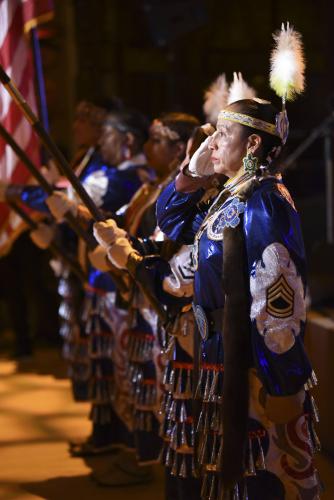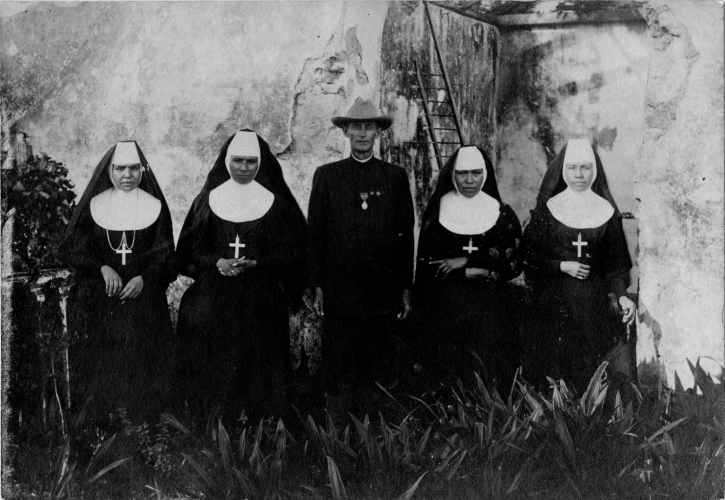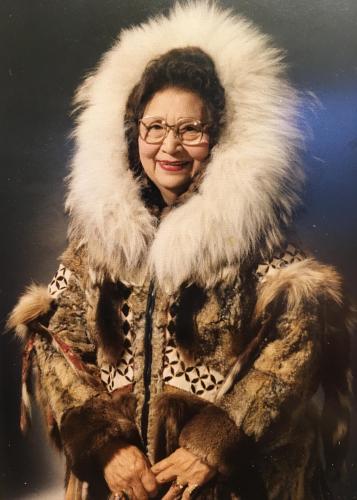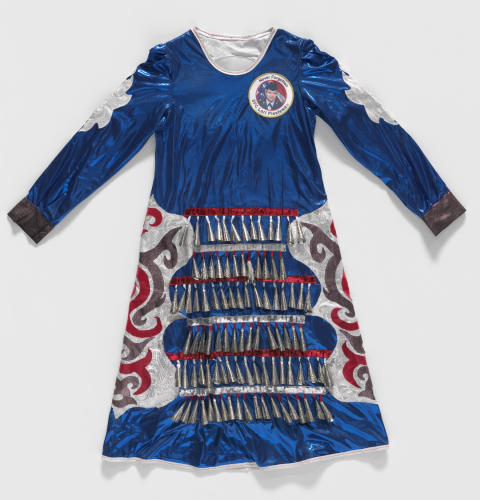
Mitchelene BigMan. Photo by Tony Powell for Smithsonian's National Museum of the American Indian.
This Veteran's Day, the Smithsonian will open a memorial to recognize the exceptional service performed by American Indian, Native Hawaiian, and Alaska Native veterans. The National Native American Veterans Memorial is located on the grounds of our National Museum of the American Indian in Washington, D.C. The memorial honors Native veterans, as well as the families who support them.
"Native peoples have served in the United States military since the American Revolution and continue to serve," said Smithsonian Secretary Lonnie G. Bunch III. "As commissioned by Congress, the memorial will recognize—for the first time on a national scale—the extraordinary service of these men and women and our shared obligation to honor this legacy."

Here are three stories about Native American women who overcame adversity and were ultimately recognized for their service.
Susie Bordeaux (Mother Mary Anthony), Ellen Clark (Sister Mary Gertrude), Annie Pleets (Sister Mary Bridget), and Josephine Two Bears (Sister Mary Joseph)
The earliest documented Native American women in the U.S. military were four Lakota nuns who served during the Spanish-American War. Susie Bordeaux (Mother Mary Anthony), Ellen Clark (Sister Mary Gertrude), Annie Pleets (Sister Mary Bridget), and Josephine Two Bears (Sister Mary Joseph) served as nurses. They came from a small sisterhood on the Fort Berthold Indian Reservation in North Dakota. Their sisterhood dissolved amid rumors of sexual behavior that were started by an Indian Department agent who resented that he was fired.
The four nuns left the reservation with the reservation's former priest, Father Francis M. Craft. The sisters enlisted to become nurses. They trained in infectious disease care at Camp Cuba Libre in Jacksonville, Florida. On December 22, 1898, all five arrived at Camp Columbia, Havana.

The sisters gained accolades for their work during the Spanish-American war. The U.S. Surgeon General wrote to praise their work. The Order of Spanish-American War Nurses adopted them as members. After their contracts were annulled, the sisters and Craft founded an orphanage in Pinar del Río, Cuba. Eventually, three of the four sisters broke with Craft and returned home to the United States. When Susie Bordeaux (Mother Many Anthony) died in Cuba of tuberculosis in 1899, she was buried in Pinar del Río with full military honors.
Laura Beltz Wright
During World War II, Laura Beltz Wright was a private in the Alaska Territorial Guard (ATG). The U.S. military enlisted nearly 6,400 Alaska Natives as volunteers to patrol Alaska in case of a Japanese invasion. Wright, one of several dozen women in the ATG, served from 1942 to 1947. She delivered mail, sometimes using skis or a dog sled. She was known as the "best shot in the company," according to Major Marvin "Muktuk" Marston, who recruited many Alaska Natives for the ATG. She once hit a target 49 out of 50 times.

Laura Beltz Wright. Courtesy of Sheila Ezell and National Museum of the American Indian.
Wright and her fellow ATG members were not granted veteran status until 2000. Wright had passed away four years earlier. Her family accepted her discharge papers at a ceremony honoring several ATG members in 2017. Sheila Ezell, Wright's granddaughter, told American Indian magazine, "I was very, very proud."
Mitchelene BigMan
U.S. Army veteran Mitchelene BigMan (Apsáalooke [Crow]/Hidatsa) served on the National Native American Veterans Memorial advisory committee.
BigMan served in the U.S. Army for 22 years. She was deployed in Operation Iraqi Freedom (2003–2004). She completed two deployments in Balad, Iraq. She has been stationed at bases in Germany, Korea, and the U.S.


Mitchelene BigMan. Photo by Tony Powell for Smithsonian's National Museum of the American Indian.
Mitchelene BigMan with fellow members of Native American Women Warriors. Photo by Tony Powell for Smithsonian's National Museum of the American Indian.
BigMan's extended family has served in the military for generations. Her grandfathers and one grandmother served in the army in World War II. Yet she did not feel welcomed by her mostly male peers. "I caught a lot of flak because I was a female, because I was a minority, and because I was Native American," she told the authors of Why We Serve: Native Americans in the United States Armed Forces. "It was three strikes against me."
In 2010, BigMan founded Native American Women Warriors (NAWW), the first recognized all-Native American Women Color Guard. NAWW brings recognition to all women veterans, especially those of Native descent. NAWW also provides support services in health, employment, and education. BigMan is the president of the organization. She wore this dress, included in Smithsonian American Women, when NAWW members appeared in the 2013 presidential inaugural parade.

To learn more about the history of Native Americans in military service, read our National Museum of the American Indian's book Why We Serve. Why We Serve co-author Alexandra Harris will take part in a conversation online on Thursday, November 12.
You can also join the museum on Veteran's Day, November 11, for a virtual program marking the completion of the memorial and honoring the service and sacrifice of Native veterans and their families.